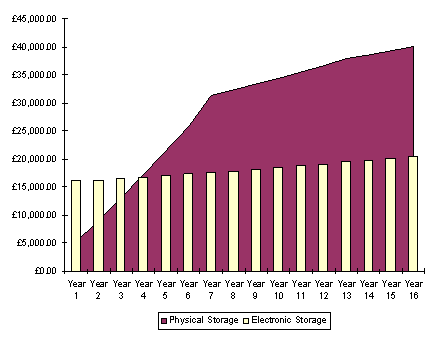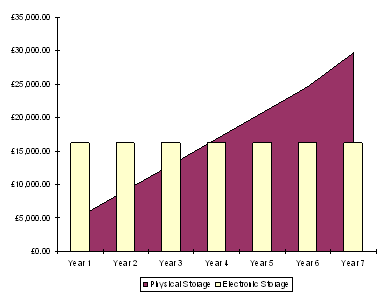Pricing Calculator
Cut over 40%* off the cost of document storage
A storage comparison calculator has been developed by thecabinetoffice for comparing the cost of physical and electronic document storage solutions. For the purposes of this article the profile of a typical professional services company, creating and storing documentation on a monthly basis, has been used to review and discuss the comparative costs. The costs associated with physical storage are taken from live examples, however each individual situation is different and the calculator is available to use for prospective clients to reflect their specific circumstance by contacting [email protected]
In our comparison the company stores an average of 40 archive boxes monthly, each with 10 client files (in the region of 2,000 sheets of paper per box), the cost for physically storing each box is 45p per month and there are administrative charges associated with booking in - £2.50 for the purchase of each archive box and £1.95 to bar code and place the boxes into store. There are additional charges on an ongoing basis for collection and delivery (£20/week) assuming a once per week delivery; and information retrieval requests, on average of 2 retrieval requests per week in the first year, increasing to on average 23 requests per week from an archive of over 3,300 archive boxes (33,000 files) in years 6 and 7. The documents are stored for 6 years, and to simplify the administration process of destruction all boxes archived during the first year are destroyed at the end of the 7th year.
In our comparison the company stores an average of 40 archive boxes monthly, each with 10 client files (in the region of 2,000 sheets of paper per box), the cost for physically storing each box is 45p per month and there are administrative charges associated with booking in - £2.50 for the purchase of each archive box and £1.95 to bar code and place the boxes into store. There are additional charges on an ongoing basis for collection and delivery (£20/week) assuming a once per week delivery; and information retrieval requests, on average of 2 retrieval requests per week in the first year, increasing to on average 23 requests per week from an archive of over 3,300 archive boxes (33,000 files) in years 6 and 7. The documents are stored for 6 years, and to simplify the administration process of destruction all boxes archived during the first year are destroyed at the end of the 7th year.
When first considering storage
|
When considering the storage of documentation there is an immediate attraction to remove archives off site and to physically store. Physical storage offers the benefit of removing all the
paperwork immediately, probably requires little immediate thought or preparation to implement and has the added attraction that cost is spread over the storage period. Over the 7 year period the cost of electronically storing is 4.8% cheaper than physical storage; however in year 7 it is over 45%* cheaper! It would pay to investigate alternative means of storing earlier as in later years this differential will increase…. |
Once the archive is established
Of course in reality, documentation is stored over longer periods, by design – and sometimes by mistake! Taking the same example but introducing the additional variables of service contract inflationary increases and variable storage periods - a picture of increasing differential cost of physical storage over electronic storage emerges. In our example the company stores 85% of the documentation for 6 years, 10% for 12 years and 5% indefinitely. For a typical Law Firm this would represent general matter files, conveyance and trust files and probate files for example. A 2% per annum increase in service charges is applied for both electronic and physical document storage from year 3 onwards.

In Year 7 the cost of electronically storing documentation is 43.8%* cheaper than physical storage; whilst in year 16 the gap has risen to 49.0%*.
It is usual for thecabinetoffice to meet clients once their archive is well established and whilst the cost of change cannot be underestimated; it is very simple to take effective steps to immediately reduce the cost of document storage.
We would generally advise clients to tackle the problem by immediately placing current documentation to be stored to an electronic rather than physical solution; and diverting all documentation retrieved from physical store to electronic format rather than placing it back into physical storage. Taking this simple action will stop feeding the legacy archive and the natural rate of document destruction will start to reduce the overall cost of physical document storage.
If the differential cost of electronic and physical storage is large enough it may pay to ‘finance’ the immediate conversion of the last 3 or 4 years of archived documentation to accelerate the decrease in the physical store and realise cost savings earlier.
In the current economic climate, where the volume of paperwork being currently generated may be much lower than in previous years, the cost of transition will be reduced, whilst the time lapsed to achieve cost reduction will be accelerated - as there is the potential that the legacy archive will contract at a rate reflecting past growth in documentation. Taking positive action today will release the benefits earlier, and whilst this article is purely focussed on the differential cost of electronic over physical storage there are other no less important benefits to be realised by storing electronically which would improve internal operating practice, such as multi user and immediate access to information and the protection of company records, which could drive costs down further.
It is usual for thecabinetoffice to meet clients once their archive is well established and whilst the cost of change cannot be underestimated; it is very simple to take effective steps to immediately reduce the cost of document storage.
We would generally advise clients to tackle the problem by immediately placing current documentation to be stored to an electronic rather than physical solution; and diverting all documentation retrieved from physical store to electronic format rather than placing it back into physical storage. Taking this simple action will stop feeding the legacy archive and the natural rate of document destruction will start to reduce the overall cost of physical document storage.
If the differential cost of electronic and physical storage is large enough it may pay to ‘finance’ the immediate conversion of the last 3 or 4 years of archived documentation to accelerate the decrease in the physical store and realise cost savings earlier.
In the current economic climate, where the volume of paperwork being currently generated may be much lower than in previous years, the cost of transition will be reduced, whilst the time lapsed to achieve cost reduction will be accelerated - as there is the potential that the legacy archive will contract at a rate reflecting past growth in documentation. Taking positive action today will release the benefits earlier, and whilst this article is purely focussed on the differential cost of electronic over physical storage there are other no less important benefits to be realised by storing electronically which would improve internal operating practice, such as multi user and immediate access to information and the protection of company records, which could drive costs down further.

